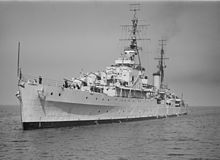HMS Bellona was the name ship of her sub-class of light cruisers for the Royal Navy. She was the first of the fourth group of Dido-class cruisers. Built to a modified design ("Improved Dido") with only four twin 5.25-inch turrets, but with remote power control for quicker elevation and training, combined with improved handling and storage of the ammunition. The light AA was improved over earlier Dido cruisers, with six twin 20mm Oerlikons and three quadruple 40mm "pom pom".
Entering service in late 1943, the cruiser operated during World War II as an escort for the Arctic convoys, and as a jamming ship to prevent the use of radio-controlled bombs and in support of the Omaha Beach landings.
In 1946 the cruiser was loaned to the Royal New Zealand Navy.
[edit]
During March and April 1947 Bellona was involved in training exercises with the Royal Australian Navy.[1] During gunnery practice a sailor, Gordon Patten, was injured and was sent to hospital for treatment where he remained for months. The cruiser returned to Devonport Naval Base in Auckland in late April and the crew were given a day's leave to attend Anzac Day services and events on Friday, 25 April.[2] Although the ship had missed the main mutiny at the start of the month, personnel from Bellona were concerned about how their colleagues had been treated and during the afternoon, about 100 sailors assembled in Quay Street, Auckland and decided not to return to duty.[2] They compiled a list of three demands—that naval pay rates be increased to match the New Zealand Army and Royal New Zealand Air Force; that committees tasked with improving the welfare of the lower ranks be established; and that the sailors involved in the previous mutiny not be persecuted or punished.[2] Another 40 sailors mustering before boarding Bellona were recruited into the mutiny. In response, Bellona's captain sent the entire complement on leave for the weekend.[2]
On Monday 28 April, a letter listing the mutineers demands was presented to the captain with the intention that it be forwarded to the Naval Board.[2] Instead of addressing the complaints, the New Zealand Naval Board declared that any sailor who did not return to duty by the morning of Tuesday 29 April would be marked as Absent Without Leave.[3] By morning parade 52 men had failed to return.[3] Those sailors were marked as having deserted even though naval regulations meant that they had to be absent for seven days before being considered deserters.[3] Once marked, the sailors lost all unpaid pay and allowances.[3] The issuing of arrest warrants for the sailors was also considered, but the cruiser's captain dismissed the suggestion.[3] Between the date of the mutiny and 23 June, when Bellona sailed on her next deployment, another 32 men returned.[3] Various charges were laid against them, ranging from "wilfully disobeying a legal command" to "joining a mutiny not accompanied by violence" and the sailors were sentenced to periods of imprisonment up to 92 days.[3]
In 1951 the cruiser was taking part in a multinational exercise in Australian waters.[4] During the exercise a Hawker Sea Fury from the Australian aircraft carrier HMAS Sydney accidentally fired four practice rockets into the superstructure of the New Zealand ship.[4] Only minor damage was caused and although an inquiry concluded that the pilot had unintentionally pressed the fire button, it was later found that certain signal frequencies transmitted by Sydney’s radios could trigger the aircraft's weapon-firing circuits.[4] By 1952 a limited attempt at modernisation was being undertaken, with the twin Oerlikons being replaced with land Mk 3 single Bofors, which were upgraded with electric power into the RNZN unique Toadstool CIWS, also refitted to HMNZS Black Prince and intended to be controlled by six STD directors which the Government was reluctant to approve with the uncertain future of the cruiser. It was intended to refit the multiple pom pom mounts to both cruisers, and they were installed for the return voyage to the UK as the RN judged Toadstool as non-standard and not as good as the RN's new electric 40mm mounts.
Bellona reverted to Royal Navy control after the transfer of the cruiser Royalist in 1956.


.jpg)





